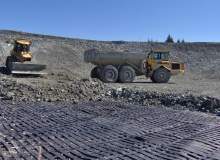
Maccaferri’s Paralink® geogrids are among the most tried and tested in the world.
Paralink is used to reinforce the ground, enabling it to support greater loads and reduce differential settlement. It is used beneath stockpiles, heap-leach pads and whenever the native soil cannot support the overburden expected.
In areas prone to settlement and subsidence due to the presence of old mine workings, Paralink geogrids are used to span the potential and known voids within the ground. This solution is particularly useful when new infrastructure or earthworks are constructed over old mine workings.
ParaLink geogrids are unique planar structures consisting of a monoaxial array of composite geosynthetics strips. Each single longitudinal strip has a core of high-tenacity polyester yarns tendons encased in a polyethylene sheath; the single strips are connected by non-resisting cross-laid polyethylene strip that gives a grid-like shape to the composite.
Paralink offers 120-year design life, ultra-high strength performance and is resistant to physical, chemical and biological conditions found in reinforced soil structures. The standard maximum ultimate tensile strength of ParaLink is 1,350kN/m, although as the manufacturer, Maccaferri is able to customise products specifically for larger projects.
Within infrastructure works, Paralink is regularly used within piled embankments to assist load-spreading from the embankment into the piles beneath. This improved efficiency often enables the pile spacing to be increased, optimising the design.
Maccaferri uses state-of-the-art software to design Paralink solutions for basal reinforcement and void spanning. This technical capability is delivered through Maccaferri’s engineers throughout the world.

